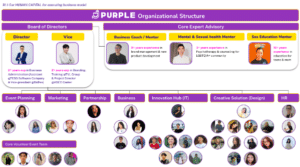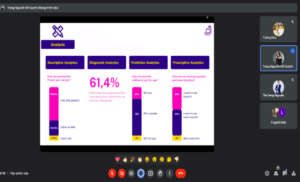SBC103 case
SBC CASE STUDY
HUMAN RESOURCES MANAGEMENT STRATEGY
–
THE KEY SUCCESS FOR PURPLE VIETNAM
PURPLE VIETNAM CASE STUDY CONTRIBUTOR
Our Coach
Mr. Trần Xuân Lĩnh
Our Members
Đỗ Quỳnh Châu
Phạm Ngọc Thúy Diễm
Đỗ Khánh Đăng
Trương Hoàng Khôi
Đỗ Hải Linh
Vũ Khánh Linh
Trần Ngọc Bảo Quỳnh
Nguyễn Tấn Sang
Trần Ngọc Thụy
Nguyễn Đỗ Quỳnh Trang
Nguyễn Kông Quỳnh Trang
Huỳnh Nhật Đoan Trinh
Phạm Thành Đức Tường
Đoàn Phương Uyên
Phan Nguyễn Tường Vy
Phan Nguyen Thuy Linh
Do Minh Quan
Le Thanh Thao
Nguyen Thi Que Tran
Nguyen Tuan Kiet
Le Thi Phuong Thao
Human resources are the most valuable assets of a business and concerned for archiving sustainable development and expansion. During the long-term path to success, the business not only needs to recruit more talents for capacity expansion, but building a system robusting employee performance, engagement and motion also plays a vital role in HRM strategy. This case study highlights Purple Vietnam’s strategy of building organizational human capital through talent management to attract and retain employees with Learning and Development (L&D) and the implication in developing a competency structure and business culture.
1. Talent Management – an outlook of attracting and retaining talents
Talent management constantlyis a constant process that involves attracting and retaining high-quality employees, developing their skills, and continuously motivating them to improve their performance (Berger, 2020). It is acknowledged by 99% of respondents that organizations’ talent management has been improving overall performance very effectively (McKinsey, 2018). Purple Vietnam’s Head of HR, who experienced in Workforce transformation at PwC, planned that our social business would drive innovation and performance by efficient talent management, from recruiting the right resources to offering them a dream place for their volunteer work.
Firstly, we deploy a plan to recruit and select talents based on the slogan: “Looking for the suitable person not the best“. It should be recognized that human capital contains knowledge, expertise, skills and experiences. However, our strategy not only depends on the above aspects, but also offers chances for talents with high volunteer engagement. To close gaps in their ability and competencies required, we deployed the CWC model following “Can do – Want to – Culture fit” across talent lifecycle. The plan was successful in attracting talents, resulting in more than 40 members voluntarily working at Purple Vietnam.
Secondly, to optimize the workflow and operations performances, Purple Vietnam builds a strong organizational structure to deliver value from planning to action consistently and work closely with experts to deliver sex education contents and business strategy. At the top is the Board of directors who aims to promote Purple Vietnam’s long-term orientation, with a team of core experts censoring the output quality, followed by the Head of Departments (Event Planning, Marketing, Partnership, Business, Technology, Design, HR) has proved team capacity to achieve our positioning & value. Purple Vietnam is honored to have the mentoring from coach of many social business projects Mr. Tran Xuan Linh, majoring product launching Furthermore, the support from 10-year-experience sex education expert Ms. Uyen & 7-year-major in Mental and Sexual health Mr. Dung provides available resources for educational contents. Currently, Purple Vietnam is still recruiting members to strengthen internal resources, with a recruitment campaign in 3 prestigious universities to increase the scale of the IT and Event Department, which meet human capital for app launching and profitable activities (workshops) as well as social campaign in highland areas.

2. Learning and Development – From the gap closed to a life-long learning culture
There were mutual aspects of individuals to consider the fit between them and the business, and Purple Vietnam indicates the importance of Learning and Development with employees to come on board. To retain talents and develop human capital, Purple Vietnam combines employees’ need for growth with the required competencies of the business.
In the on-boarding stage, the HR department makes a quick assessment for new staff to identify the current lack of productive work and the skills needed to respond to future change. Then, survey the current level of mastery of the set skills compared to the target to be achieved, thereby offering an appropriate training program. Each department has a specific program that provides related professional and soft skills. At the end step of L&D program, we evaluate the effectiveness of training based on whether the employee’s work output meets the criteria set out in the initial step.
Purple Vietnam applies blended online training throughout the L&D process. Specifically, the B.O.D department will conduct the first part of the training so that the staff can get acquainted, collect interaction and guide how to learn, then the staff will have more corresponding lecture modules to self-study in their free time. At the end of the week, there will be a meeting for Q&A to answer HR questions. The arrangement of the training program in modules helps staff reuse lecture materials and ensures their understanding and knowledge through Q&A sessions.
In addition, Purple Vietnam also applies the “upskilling” method, through which departmental employees will be trained more in areas outside their expertise. For example, HR staff will receive more training in digital marketing to implement the HRM strategy more effectively. In addition, personnel are also equipped with training sessions to improve soft skills such as adaptability and stress reduction or work-life balance.
Purple Vietnam aims to keep employees enthusiastic and willing to go the extra mile by building a skills matrix divided by Departments and Employees’ roles. We also set employee goals through various strategies such as making a Learning Path, making a list of useful courses, personal reflection & material recommendations for reading. Purple Vietnam ensures all employees are well motivated and fully engaged in performing their tasks. Our first motivating factor is to ensure people do what they like most. For example, IT engineers are usually given an opportunity to decide which part of the company they fit well. They are also given a chance to work in a cross-function department to have a meaningful impact on the company. This strategy has ensured that employees are engaged in what they do, which has contributed to the company’s accelerated growth.
Purple Vietnam emphasizes staff involvement as well. We succeed in achieving this goal by highlighting the mechanisms of performance evaluation, rewards, and empowerment. After identifying extrinsic and intrinsic motivation to ensure team members’ willingness to do, Purple Vietnam gives staff members new challenging responsibilities that keep them engaged and push their boundaries. As a result, we inspire our workers by giving them difficult tasks by highlighting the critical missions of each task that help them stay motivated and gain expertise in a new field. Employees will receive certificates from firms that deal with organizations after each phase, based on rewards for their areas of expertise, giving them the opportunity to make a mark on their professional profiles. Employees will be empowered to become transformational leaders in different activities, which enhances leadership and motivation. The main responsibility of the top management in an organization is to share a vision and ensure employees are engaged with this vision. Purple Vietnam considers when the vision is shared appropriately, it arouses teamwork in the company. It also promotes optimism, enthusiasm and intellectual stimulation. The intellectual stimulation makes employees become innovative and creative to advance the company’s values and beliefs.

3. Competency – A comprehensive assessment across employee life cycle
Purple Vietnam uses competency frameworks to identify, develop and reinforce certain types of behaviors that are required to achieve organizational success. A competency is defined as the specific set of skills, knowledge and behavior required to effectively complete particular work tasks. Unlike aptitudes or personality traits, which are relatively enduring and stable over time, competencies can be acquired and refined through appropriate mentoring, coaching and training.
The Behavioral Assessment Interview (BEI) and Project Case Assessment are the two capacity assessment methods used by Purple Vietnam. The first type of assessment consists of a series of focused assessment interview questions to identify personal strengths and shortcomings. It is primarily utilized during the hiring process to evaluate a candidate’s personality immediately. The second model is used to develop and foster internal culture over the whole employee life cycle. Employees will thus demonstrate their level through collaborative group initiatives.
Purple Vietnam has identified two main universal competency groups. The first group is “Competency for the way we WORK”, which includes 4 Skills and knowledge essential to help Purple Vietnam succeed. Knowledge of sexuality plays a leading role, associated with our vision is to provide teenagers from all parts of the country with Communication Skills ranks second for conveying complex information in a clear, non-judgmental, and age-appropriate manner and engaging diverse audiences. The second universal competency group is “Competency for “the way we PERFORM”, including 4 Skills and personality required to drive working culture. Collaboration and networking plays the most important role in this group, with the main role being engaging with citizens and multiple stakeholders to ensure co-creation and collaborative ownership of new solutions. Ethics and professionalism take a second role intending to address sensitive topics, respond to individuals’ emotional needs with care and manage personal emotions and reactions during challenging discussions.
4. Organizational culture – A sense of belonging
Purple Vietnam’s workforce is represented by people belonging to various universities and backgrounds. The main advantage of this policy is that it enables us to recruit and retain the most talented candidates. Our current workforce includes 37 members with diverse backgrounds and experience from 10+ different universities in the North & South of Vietnam. Additionally, Purple Vietnam lays stress on the importance of family-friendly practices. For instance, employees can work out a more flexible schedule by filling in the weekly busy schedule. Furthermore, in many cases, they can be allowed to do their job at home.
Purple Vietnam follows structure from planning to action consistently, and ensures our D.E.I culture (Diversity – Equity – Inclusive). It plays a crucial role in shaping the effectiveness, success and engagement in the business of sex education like Purple. Firstly, Purple Vietnam welcomes a different dimension of diversity. Purple Vietnam can relate to and service a variety of consumers because of a diversified team with varied viewpoints and experiences. Additionally, employees may readily share new knowledge and learn from one another, enhancing the standard of work output. Secondly, no discrimination, bullying – same opportunities access ensures that Purple Vietnam complies with anti-discrimination laws and regulations and mitigates the risk of legal issues arising from discriminatory practices. Finally, treating each other with dignity and respect encourages collaboration among employees with different perspectives, leading to more well-rounded decision-making and problem-solving. Moreover, it ensures all employees feel their voices will be heard.
Social business requires critical strategic planning to optimize the performance, and HRM strategy is not exclusive. With strategic HR planning, we have utilized talent management, L&D to attract, retain and manage our employees to success. In the future, Purple Vietnam will continuously improve the competency systems, culture, and updating HRM strategy, to enhance the human capital and our business expansion.
REFERENCES
- Berger, L. A., & Berger, D. R. (2020). The Talent Management Handbook: Creating Organizational Excellence by Identifying, Developing, and Promoting Your Best People (3rd ed.). McGraw-Hill Education.
- McKinsey & Company (2018) Winning with your talent-management strategy. Available at: https://www.mckinsey.com/capabilities/people-and-organizational-performance/our-insights/winning-with-your-talent-management-strategy

